Seagrass
| Seagrasses Temporal range:
| |
|---|---|

| |
| Zostera marina – the most abundant seagrass species in the Northern Hemisphere | |
| Scientific classification | |
| Kingdom: | Plantae |
| Clade: | Tracheophytes |
| Clade: | Angiosperms |
| Clade: | Monocots |
| Order: | |
| Families | |
|
See Taxonomy | |
Seagrasses are the only
The name seagrass stems from the many species with long and narrow
Like all
Seagrasses form dense underwater seagrass meadows which are among the most productive ecosystems in the world. They function as important carbon sinks[3] and provide habitats and food for a diversity of marine life comparable to that of coral reefs.
Overview
Seagrasses are a paraphyletic group of marine
Seagrasses profoundly influence the physical, chemical, and biological environments of coastal waters.
Seagrasses form important
Evolution
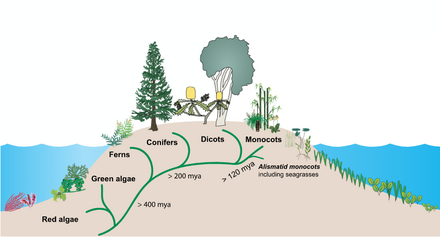
Around 140 million years ago, seagrasses evolved from early monocots which succeeded in conquering the marine environment.
Other plants that colonised the sea, such as
Recent
Taxonomy
Today, seagrasses are a polyphyletic group of marine angiosperms with around 60 species in five families (
| Family | Image | Genera | Description |
|---|---|---|---|
| Zosteraceae | The family coastal waters, with the highest diversity located around Korea and Japan.Species subtotal:
| ||
 |
Phyllospadix | ||
 |
Zostera | ||
| Hydrocharitaceae | The family Hydrocharitaceae, also known as tape-grasses, include Canadian waterweed and frogbit. The family includes both fresh and marine aquatics, although of the sixteen genera currently recognised, only three are marine.[22] They are found throughout the world in a wide variety of habitats, but are primarily tropical. Species subtotal:
| ||
 |
Enhalus | ||
 |
Halophila | ||
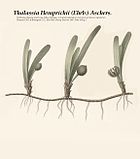 |
Thalassia
|
2 species | |
Posidoniaceae
|
The family Mediterranean and around the south coast of Australia .Species subtotal: 2 to 9
| ||
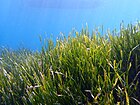 |
Posidonia | ||
| Cymodoceaceae | The family Cymodoceaceae, also known as manatee-grass, includes only marine species.[23] Some taxonomists do not recognize this family. Species subtotal:
| ||
 |
Amphibolis | ||
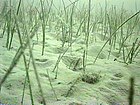 |
Cymodocea | ||
 |
Halodule | ||
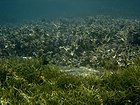 |
Syringodium | ||
 |
Thalassodendron | ||
| Total species: | |||
Sexual recruitment
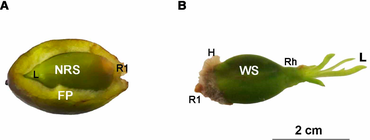
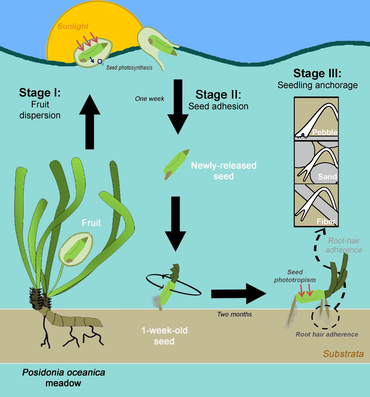
dispersion, adhesion and settlement
Seagrass populations are currently threatened by a variety of anthropogenic stressors.[25][7] The ability of seagrasses to cope with environmental perturbations depends, to some extent, on genetic variability, which is obtained through sexual recruitment.[26][27][28] By forming new individuals, seagrasses increase their genetic diversity and thus their ability to colonise new areas and to adapt to environmental changes.[29][30][31][32][33][24][excessive citations]
Seagrasses have contrasting
The seagrass
Intertidal and subtidal
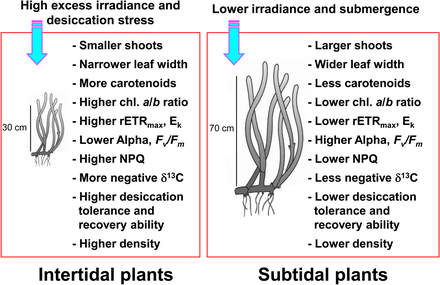
Seagrasses occurring in the intertidal and subtidal zones are exposed to highly variable environmental conditions due to tidal changes.[52][53] Subtidal seagrasses are more frequently exposed to lower light conditions, driven by plethora of natural and human-caused influences that reduce light penetration by increasing the density of suspended opaque materials. Subtidal light conditions can be estimated, with high accuracy, using artificial intelligence, enabling more rapid mitigation than was available using in situ techniques.[54] Seagrasses in the intertidal zone are regularly exposed to air and consequently experience extreme high and low temperatures, high photoinhibitory irradiance, and desiccation stress relative to subtidal seagrass.[53][55][56] Such extreme temperatures can lead to significant seagrass dieback when seagrasses are exposed to air during low tide.[57][58][59] Desiccation stress during low tide has been considered the primary factor limiting seagrass distribution at the upper intertidal zone.[60] Seagrasses residing the intertidal zone are usually smaller than those in the subtidal zone to minimize the effects of emergence stress.[61][58] Intertidal seagrasses also show light-dependent responses, such as decreased photosynthetic efficiency and increased photoprotection during periods of high irradiance and air exposure.[62][63]
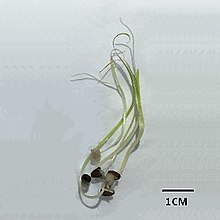
In contrast, seagrasses in the
Seagrasses assimilate large amounts of
Seagrass meadows
Seagrass beds are diverse and productive
Seagrasses trap sediment and slow down water movement, causing suspended sediment to settle out. Trapping sediment benefits coral by reducing sediment loads, improving photosynthesis for both coral and seagrass.[78]
Although often overlooked, seagrasses provide a number of
-
seagrass bed
-
White-spotted puffers, often found in seagrass areas
-
Underwater footage of seagrass meadow,conger eel
Seagrass microbiome
Seagrass holobiont
The concept of the holobiont, which emphasizes the importance and interactions of a microbial host with associated microorganisms and viruses and describes their functioning as a single biological unit,[92] has been investigated and discussed for many model systems, although there is substantial criticism of a concept that defines diverse host-microbe symbioses as a single biological unit.[93] The holobiont and hologenome concepts have evolved since the original definition,[94] and there is no doubt that symbiotic microorganisms are pivotal for the biology and ecology of the host by providing vitamins, energy and inorganic or organic nutrients, participating in defense mechanisms, or by driving the evolution of the host.[95]
Although most work on host-microbe interactions has been focused on animal systems such as corals, sponges, or humans, there is a substantial body of literature on plant holobionts.[96] Plant-associated microbial communities impact both key components of the fitness of plants, growth and survival,[97] and are shaped by nutrient availability and plant defense mechanisms.[98] Several habitats have been described to harbor plant-associated microbes, including the rhizoplane (surface of root tissue), the rhizosphere (periphery of the roots), the endosphere (inside plant tissue), and the phyllosphere (total above-ground surface area).[90] The microbial community in the P. oceanica rhizosphere shows similar complexity as terrestrial habitats that contain thousands of taxa per gram of soil. In contrast, the chemistry in the rhizosphere of P. oceanica was dominated by the presence of sugars like sucrose and phenolics.[99]
Cell walls
Seagrass
In addition to polysaccharides, glycoproteins of the hydroxyproline-rich glycoprotein family,[105] are important components of cell walls of land plants. The highly glycosylated arabinogalactan proteins are of interest because of their involvement in both wall architecture and cellular regulatory processes.[106][107] Arabinogalactan proteins are ubiquitous in seed land plants[107] and have also been found in ferns, lycophytes and mosses.[108] They are structurally characterised by large polysaccharide moieties composed of arabinogalactans (normally over 90% of the molecule) which are covalently linked via hydroxyproline to relatively small protein/peptide backbones (normally less than 10% of the molecule).[107] Distinct glycan modifications have been identified in different species and tissues and it has been suggested these influence physical properties and function. In 2020, AGPs were isolated and structurally characterised for the first time from a seagrass.[109] Although the common backbone structure of land plant arabinogalactan proteins is conserved, the glycan structures exhibit unique features suggesting a role of seagrass arabinogalactan proteins in osmoregulation.[110][10]
Further components of secondary walls of plants are cross-linked phenolic polymers called lignin, which are responsible for mechanical strengthening of the wall. In seagrasses, this polymer has also been detected, but often in lower amounts compared to angiosperm land plants.[111][112][113][114][10] Thus, the cell walls of seagrasses seem to contain combinations of features known from both angiosperm land plants and marine macroalgae together with new structural elements. Dried seagrass leaves might be useful for papermaking or as insulating materials, so knowledge of cell wall composition has some technological relevance.[10]
Threats and conservation
Despite only covering 0.1 - 0.2% of the ocean’s surface, seagrasses form critically important ecosystems. Much like many other regions of the ocean, seagrasses have been faced with an accelerating global decline.[115] Since the late 19th century, over 20% of the global seagrass area has been lost, with seagrass bed loss occurring at a rate of 1.5% each year.[116] Of the 72 global seagrass species, approximately one quarter (15 species) could be considered at a Threatened or Near Threatened status on the IUCN’s Red List of Threatened Species.[117] Threats include a combination of natural factors, such as storms and disease, and anthropogenic in origin, including habitat destruction, pollution, and climate change.[115]
By far the most common threat to seagrass is human activity.
Seagrasses are also negatively affected by changing global climatic conditions. Increased weather events, sea level rise, and higher temperatures as a result of global warming all have the potential to induce widespread seagrass loss. An additional threat to seagrass beds is the introduction of non-native species. For seagrass beds worldwide, at least 28 non-native species have become established. Of these invasive species, the majority (64%) have been documented to infer negative effects on the ecosystem.[120]
Another major cause of seagrass disappearance is
Possible seagrass population trajectories have been studied in the Mediterranean sea. These studies suggest that the presence of seagrass depends on physical factors such as temperature, salinity, depth and turbidity, along with natural phenomena like climate change and anthropogenic pressure. While there are exceptions, regression was a general trend in many areas of the Mediterranean Sea. There is an estimated 27.7% reduction along the southern coast of Latium, 18%-38% reduction in the Northern Mediterranean basin, 19%-30% reduction on Ligurian coasts since the 1960s and 23% reduction in France in the past 50 years. In Spain the main reason for regression was due to human activity such as illegal trawling and aquaculture farming. It was found that areas with medium to high human impact suffered more severe reduction. Overall, it was suggested that 29% of known areal seagrass populations have disappeared since 1879. The reduction in these areas suggests that should warming in the Mediterranean basin continue, it may lead to a functional extinction of Posidonia oceanica in the Mediterranean by 2050. Scientists suggested that the trends they identified appear to be part of a large-scale trend worldwide.[122]
Conservation efforts are imperative to the survival of seagrass species. While there are many challenges to overcome with respect to seagrass conservation there are some major ones that can be addressed. Societal awareness of what seagrasses are and their importance to human well-being is incredibly important. As the majority of people become more urbanized they are increasingly more disconnected from the natural world. This allows for misconceptions and a lack of understanding of seagrass ecology and its importance. Additionally, it is a challenge to obtain and maintain information on the status and condition of seagrass populations. With many populations across the globe, it is difficult to map the current populations. Another challenge faced in seagrass conservation is the ability to identify threatening activities on a local scale. Also, in an ever growing human population, there is a need to balance the needs of the people while also balancing the needs of the planet. Lastly, it is challenging to generate scientific research to support conservation of seagrass. Limited efforts and resources are dedicated to the study of seagrasses.[123] This is seen in areas such as India and China where there is little to no plan in place to conserve seagrass populations. However, the conservation and restoration of seagrass may contribute to 16 of the 17 UN Sustainable Development Goals.[124]
In a study of seagrass conservation in China, several suggestions were made by scientists on how to better conserve seagrass. They suggested that seagrass beds should be included in the Chinese conservation agenda as done in other countries. They called for the Chinese government to forbid land reclamation in areas near or in seagrass beds, to reduce the number and size of culture ponds, to control raft aquaculture and improve sediment quality, to establish seagrass reserves, to increase awareness of seagrass beds to fishermen and policy makers and to carry out seagrass restoration.[125] Similar suggestions were made in India where scientists suggested that public engagement was important. Also, scientists, the public, and government officials should work in tandem to integrate traditional ecological knowledge and socio-cultural practices to evolve conservation policies.[126]
World Seagrass Day is an annual event held on March 1 to raise awareness about seagrass and its important functions in the marine ecosystem.[127][128]
See also
- Alismatales
- Blue carbon
- Salt marsh
- Mangrove
- Sea rewilding
- Nursery habitat
- Ocean Data Viewer: contains the global distribution of seagrasses dataset
References
- ^ Tomlinson and Vargo (1966). "On the morphology and anatomy of turtle grass, Thalassia testudinum (Hydrocharitaceae). I. Vegetative Morphology". Bulletin of Marine Science. 16: 748–761.
- PMID 27680661.
- ^ "39 Ways to Save the Planet - Sublime Seagrass". BBC Radio 4. BBC. Retrieved 12 February 2022.
- ^ doi:10.5402/2012/103892..
 Material was copied from this source, which is available under a Creative Commons Attribution 3.0 International License
Material was copied from this source, which is available under a Creative Commons Attribution 3.0 International License - ^ Larkum A. W. D., R. J. Orth, and C. M. Duarte (2006) Seagrass: Biology, Ecology and Conservation, Springer, The Netherlands.
- S2CID 4936412.
- ^ PMID 19587236.
- S2CID 32533417.
- ^ Hemminga, M. A., and Duarte, C. M. eds (2000). “Seagrasses in the human environment,” in Seagrass Ecology (Cambridge: Cambridge University Press), 248–291.
- ^ PMID 33193541..
 Material was copied from this source, which is available under a Creative Commons Attribution 4.0 International License
Material was copied from this source, which is available under a Creative Commons Attribution 4.0 International License - )
- S2CID 4398942.
- ^ S2CID 4936412.
- ^ a b c Papenbrock, J (2012). "Highlights in seagrass' phylogeny, physiology, and metabolism: what makes them so species?". International Scholarly Research Network: 1–15.
- ^ Les, D.H., Cleland, M.A. and Waycott, M. (1997) "Phylogenetic studies in Alismatidae, II: evolution of marine angiosperms (seagrasses) and hydrophily". Systematic Botany 22(3): 443–463.
- S2CID 4936412.
- ^ PMID 27373688.
- ^ S2CID 3713147.
- S2CID 7498637.
- ISBN 9781107244603.
- ^ The Plant List (2020). Ruppia. Available online at: http://www.theplantlist.org/1.1/browse/A/Ruppiaceae/Ruppia/ (accessed September 22, 2020).
- ISSN 1179-3163.
- ISBN 9781486300150.
- ^ PMID 30444902..
 Material was copied from this source, which is available under a Creative Commons Attribution 4.0 International License
Material was copied from this source, which is available under a Creative Commons Attribution 4.0 International License - PMID 24793782.
- PMID 15710890.
- PMID 30444902.
- .
- ISBN 978-1-4020-2942-4.
- .
- ISBN 9781107415324.
- PMID 25297859.
- PMID 27592387.
- ^ doi:10.1071/PC000251.
- .
- ^ Kuo J, Den Hartog C. (2006) "Seagrass morphology, anatomy, and ultrastructure". In: Larkum AWD, Orth RJ, Duarte CM (Eds), Seagrasses: Biology, Ecology and Conservation, Springer, pages 51–87.
- .
- ^ PMID 22312426.
- S2CID 130872337.
- ^ PMID 28220127.
- S2CID 85362624.
- S2CID 11523686.
- S2CID 84055440.
- .
- S2CID 84357626.
- .
- hdl:11568/755031.
- S2CID 88876962.
- PMID 25740176.
- .
- PMID 27227327..
 Material was copied from this source, which is available under a Creative Commons Attribution 4.0 International License
Material was copied from this source, which is available under a Creative Commons Attribution 4.0 International License - .
- ^ S2CID 85105171.
- S2CID 233519731.
- S2CID 85627116.
- ^ S2CID 86386210.
- ^ Hemminga M. A. and Durate C. M. (2000) Seagrass ecology. Cambridge University Press.
- ^ .
- ^ Hirst A, Ball D, Heislers S, Young P, Blake S, Coots A. Baywide Seagrass Monitoring Program, Milestone Report No. 2 (2008). Fisheries Victoria Technical Report No. 29, January 2009.
- S2CID 85287808.
- .
- .
- hdl:10453/23914.
- PMID 27896031..
 Material was copied from this source, which is available under a Creative Commons Attribution 4.0 International License
Material was copied from this source, which is available under a Creative Commons Attribution 4.0 International License - S2CID 86384408.
- .
- .
- .
- .
- .
- .
- .
- ^ Larkum AWD, James PL. Towards a model for inorganic carbon uptake in seagrasses involving carbonic anhydrase. In Kuo J, Phillips RC, Walker DI, Kirkman H, editors. Seagrass biology: Proceedings of an International Workshop. Nedlands: The University of Western Australia; 1996. pp. 191–196.
- .
- .
- JSTOR 1310735.
- PMID 32689482.
- ^ Seagrass-Watch: What is seagrass? Retrieved 2012-11-16.
- PMID 27732600.
- ^ United Nations Environment Programme (2020). Out of the blue: The value of seagrasses to the environment and to people. UNEP, Nairobi. https://www.unenvironment.org/resources/report/out-blue-value-seagrasses-environment-and-people
- ^ JSTOR 3545850.
- .
- S2CID 88685282.
- PMID 23948090.
- ^ "Seagrass FAQ". Florida Fish And Wildlife Conservation Commission.
- .
- .
- .
- ^ a b Boucek, R. E.; Leone, E.; Bickford, J.; Walters-Burnsed, S.; Lowerre-Barbieri, S. (2017). "More than just a spawning location: Examining fine-scale s[ace use of two estuarine fish species at a spawning aggregation site". Frontiers in Marine Science (4): 1–9.
- ^ doi:10.3390/microorganisms5040081..
 Material was copied from this source, which is available under a Creative Commons Attribution 4.0 International License
Material was copied from this source, which is available under a Creative Commons Attribution 4.0 International License - .
- ISBN 9780262132695.
- .
- .
- .
- .
- .
- .
- PMID 35501482.
- .
- ^ PMID 15317737.
- .
- PMID 20465284.
- PMID 26110894.
- PMID 14645732.
- PMID 20388666.
- ^ S2CID 104384164.
- S2CID 73426733.
- PMID 32427862.
- PMID 16411951.
- .
- .
- S2CID 17409200.
- S2CID 105104424.
- ^ S2CID 31971900.
- PMID 19587236.
- ^ S2CID 32533417.
- ISSN 0024-3590.
- ISBN 978-0-521-66184-3.
- ^ S2CID 4936412.
- ^ ISSN 0022-0981.
- PMID 26216526.
- PMID 30456457.
- S2CID 251347987.
- S2CID 232775373.
- PMID 22112297.
- ^ Mohsin, Haroon (24 June 2022). "World Seagrass Day". National Today.
- ^ "World Seagrass Day". World Seagrass Association. 10 June 2018. Retrieved 14 July 2022.
Further references
- den Hartog, C. 1970. The Sea-grasses of the World. Verhandl. der Koninklijke Nederlandse Akademie van Wetenschappen, Afd. Natuurkunde, No. 59(1).
- Duarte, Carlos M. and Carina L. Chiscano “Seagrass biomass and production: a reassessment” Aquatic Botany Volume 65, Issues 1–4, November 1999, Pages 159–174.
- Green, E.P. & Short, F.T.(eds). 2003. World Atlas of Seagrasses. University of California Press, Berkeley, CA. 298 pp.
- Hemminga, M.A. & Duarte, C. 2000. Seagrass Ecology. Cambridge University Press, Cambridge. 298 pp.
- Hogarth, Peter The Biology of Mangroves and Seagrasses (Oxford University Press, 2007)
- Larkum, Anthony W.D., Robert J. Orth, and Carlos M. Duarte (Editors) Seagrasses: Biology, Ecology and Conservation (Springer, 2006)
- Orth, Robert J. et al. "A Global Crisis for Seagrass Ecosystems" BioScience December 2006 / Vol. 56 No. 12, Pages 987–996.
- Short, F.T. & Coles, R.G.(eds). 2001. Global Seagrass Research Methods. Elsevier Science, Amsterdam. 473 pp.
- A.W.D. Larkum, R.J. Orth, and C.M. Duarte (eds). Seagrass Biology: A Treatise. CRC Press, Boca Raton, FL, in press.
- A. Schwartz; M. Morrison; I. Hawes; J. Halliday. 2006. Physical and biological characteristics of a rare marine habitat: sub-tidal seagrass beds of offshore islands. Science for Conservation 269. 39 pp. [1]
- Waycott, M, McMahon, K, & Lavery, P 2014, A guide to southern temperate seagrasses, CSIRO Publishing, Melbourne
External links
- Cullen-Unsworth, Leanne C.; Unsworth, Richard (3 August 2018). "A call for seagrass protection". Science. 361 (6401): 446–448. S2CID 51908021.
- Project Seagrass - Charity advancing the conservation of seagrass through community, research and action
- Seagrasses Project Regeneration.
- SeagrassSpotter - Citizen Science project raising awaress for seagrass meadows and mapping their locations
- Seagrass and Seagrass Beds overview from the Smithsonian Ocean Portal
- Nature Geoscience article describing the locations of the seagrass meadows around the world
- Seagrass-Watch - the largest scientific, non-destructive, seagrass assessment and monitoring program in the world
- Restore-A-Scar - a non-profit campaign to restore seagrass meadows damaged by boat props
- SeagrassNet - global seagrass monitoring program
- The Seagrass Fund at The Ocean Foundation
- Taxonomy of seagrasses
- World Seagrass Association
- SeagrassLI
- Seagrass Science and Management in the South China Sea and Gulf of Thailand
- Marine Ecology (December 2006) - special issue on seagrasses
- Cambodian Seagrasses
- Seagrass Productivity - COST Action ES0906
- Fisheries Western Australia - Seagrass Fact Sheet




